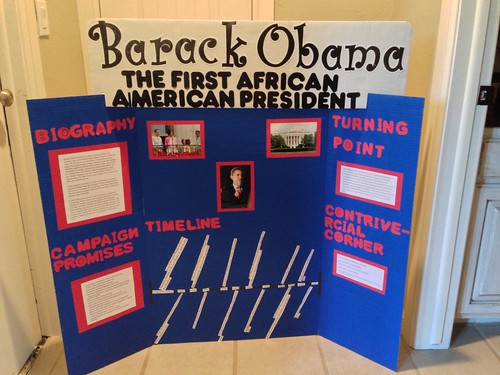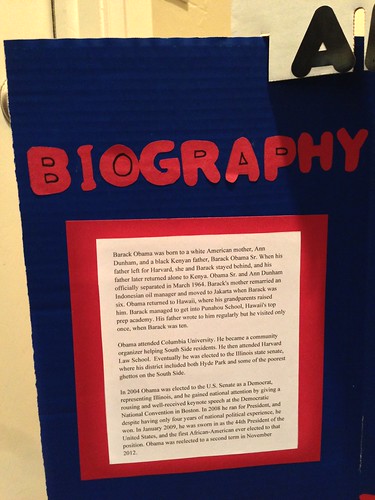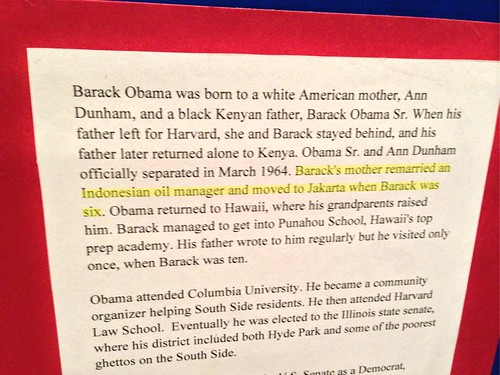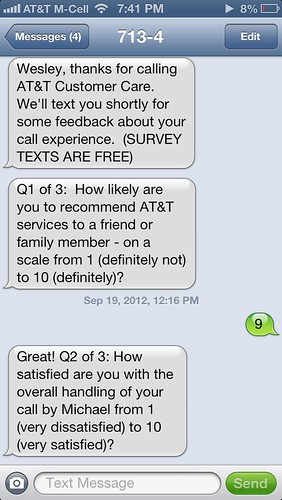(A shortened, edited version of this post is also available as, “A Story About Plagiarsim and Group Projects.”)
The past couple weeks my 7th grade daughter has been working on a National History Day project for her social studies class. Today she proudly showed me the display board which her group created about our president.
Of course I want to recognize and encourage the hard work she has put into this project over multiple days, but the first thing I thought when I started reading her group report was, “Did the students simply copy and paste this information from the web or did they write this in their own words?”
To find out, I googled one of the sentences in the first paragraph of the report. I actually used Siri on my iPhone to simply read this sentence, and let Google do the search:
Barack’s mother remarried an Indonesian oil manager and moved to Jakarta when Barack was six.
The first result is the IMDB entry for President Obama, which has that sentence in it word-for-word, verbatim.
I asked my daughter if her teacher had discussed plagiarism with her, or if ANY of her other teachers in 7th grade had discussed plagiarism. She said no. She knew their group was supposed to write their report in their own words, but the group member who was responsible for that portion of the report turned in her article on a flash drive and other members hadn’t reviewed it. They simply printed it and added it to the display board.
I explained to my daughter that clear plagiarism like this, when she (or her group members) copy something word-for-word and don’t cite it as a quotation, is a reason to get an “F” on a project like this at many schools and colleges. She was crushed to hear this.
Given that the teacher who assigned this project and will be evaluating it is the same one who has students regularly copy pages of their textbook verbatim (see my September 2012 post, “Copying the Textbook is NOT an Acceptable Assignment“) I’m doubtful he will catch this and grade my daughter’s group on the project accordingly. Of course I think my daughter should re-do the assignment with her group and do it right, but at this point I’m not sure what’s she’s going to choose to do.
Tools like TurnItIn.com are used by many colleges and universities to address plagiarism, but I’m not aware of any K-12 schools in Oklahoma paying for it or a similar service. In cases like this, however, it’s not necessary to pay for a service to identify plagiarism… a simple Google search with quotation marks (an exact phrase search) is all that’s needed.
Are you teaching your students about plagiarism, and how to use Google to check themselves as well as their classmates’ work? Every one of us teaching students, who do any type of Internet research, needs to be talking about these issues. While the Internet makes it incredibly easy to copy and paste content INTO a report, tools like Google also make it incredibly easy for teachers (and parents) to identify plagiarism when it happens. See my my January 2008 post, “Plagiarism, WikiPedia, and encouraging students to CARE about digital ethics,” for additional thoughts on this topic.
This ethical situation not only puts my daughter in a challenging situation, where she will have to decide if she’ll share this with her group members and work with them to re-write their plagiarized paragraphs, it also puts me in a challenging spot. Should I meet with this teacher AGAIN, but this time point out the plagiarism of my own child, suggest he address plagiarism directly with his classes, and show him how to use Google to find/prove cases of plagiarism?
I probably won’t. The last meeting I had with this teacher led to my daughter being negatively singled out in class in some other situations, and we both felt it was because of the individual meeting I’d had with the teacher. I don’t want to make the situation in this class worse for her than it already is. It’s a bad situation, and I think my capabilities as a parent to constructively improve it are marginal to nonexistent. (I formed this opinion AFTER meeting with the teacher and discussing instructional issues at length…)
This situation and others my own children have had in the past few years reinforce my conviction that public relations campaigns like the A-F report card in Oklahoma are ABSOLUTELY WORTHLESS when it comes to the important, practical work which needs to be done in improving the quality of learning and instruction in our classrooms. A-F does NOTHING to improve instruction and learning in our schools.
We CAN do many things to address issues like this, however. The two ideas foremost on my mind, which we need, are:
- Opportunities for teachers to work with instructional coaches on a regular (or at least periodic) basis, to improve their assignments, pedagogy, relationships with students, etc.
- Opportunities for students as well as parents to regularly provide feedback on the quality of learning experiences taking place, aggregated at the CLASSROOM / TEACHER level. My two oldest children attend a fantastically rated public school, but in that public school they’ve had some VERY poor and negative academic experiences because of teacher issues. 99% of the quality of classroom learning experiences comes down to the TEACHER and what s/he does or does not do. Open and regular feedback from parents and students which is documented in writing could help. I favor weekly text messaging surveys similar to the ones my dentist sends after each office visit, or like the surveys AT&T sends after you talk with a representative on the phone.
Besides talking with my daughter about this situation and encouraging her to remedy it now and avoid it in the future, the most constructive thing I can think of doing in this situation is to encourage YOU to please teach your own students about plagiarism and how to use Google to identify and avoid it too.
Technorati Tags: edtech, google, research, technology, plagiarism






Comments
2 responses to “Use Google to Identify Plagiarism & Teach How to Avoid Committing It”
Dear Wesley,
I appreciated your article from the point of view of being a teacher.
You are describing a problem that is probably not unusual. I was in a class where a teacher expected the students to copy and paste images into their reports. There was no recognition of copyright ethics. She was having management issues with the students, who were choosing commercial pictures that were academically inappropriate. I created a Diigo list for creative commons pictures. My list had no inappropriate pictures, and they were available to use when attributed to the sources. I asked the teacher if she way my resource. She didn’t want to use this. She was satisfied with her current approach, and just wanted to continue her way of doing things.
Teachers don’t like to be told what to do or how to do it. They see feedback as criticism. The new LAUSD teacher evaluation system is still being negotiated between the administration and the Union. The Union is resisting the emphasis on test results in teacher evaluation. I would expect them to resist any system that incorporates authentic feedback.
It is up to the community as consumers to demand a higher standard. I understand that your daughter’s teacher doesn’t want to hear what you have to say, and will push back and target your daughter if he finds out that you are overseeing his methods. Maybe there is a way to approach an administrator without the teacher knowing it was you. I believe that a school establishes a culture from the top down. Either there is an openness to change and growth, or there is an atmosphere of defensiveness and rigidity.
Good luck with this. You have the right to demand a quality education for your children. This is public school. In a private school there is no recourse. You can exercise that right if you choose. I believe that in the long run it will be better for everyone.